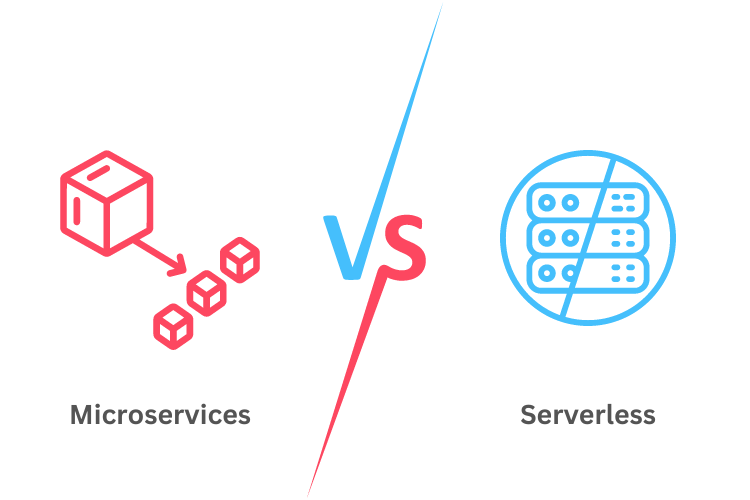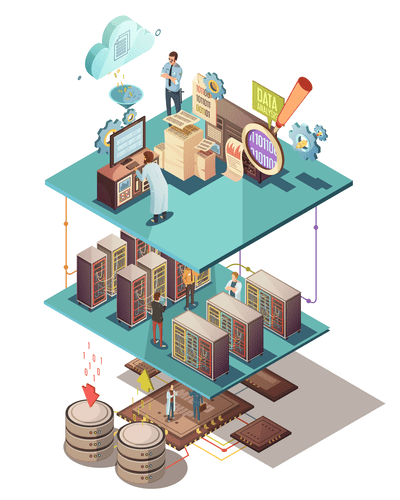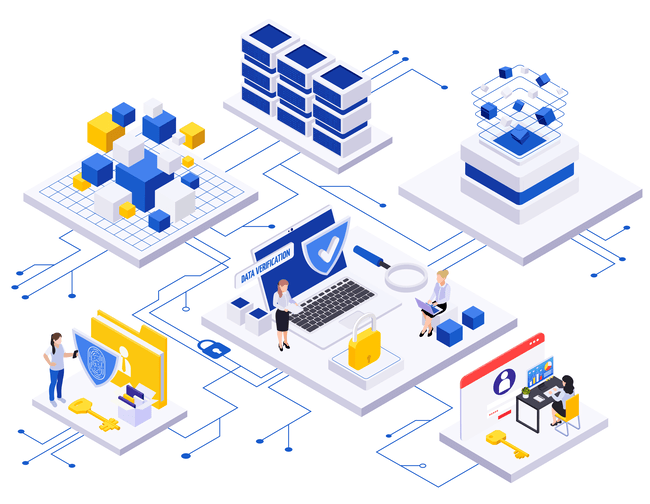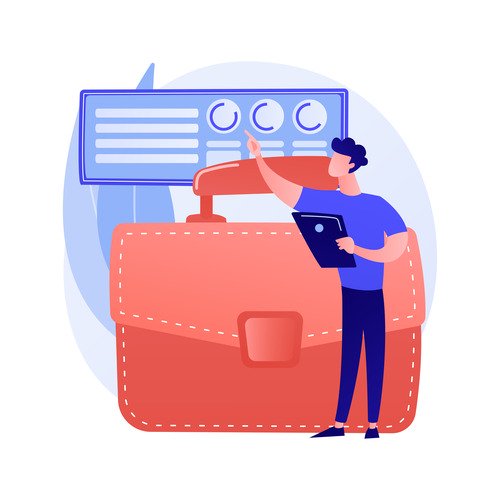
Here’s a detailed discussion about the key parameters that you need to factor in while comparing the compatibility of serverless vs microservices architecture with your business’s software development requirements.
Want to develop your software solution with an architecture model that fits your business needs flawlessly? Well, in that case, you’re most likely conflicted between choosing one of the two most in-demand options the market currently offers: serverless vs microservices architecture. It requires a thorough understanding of your business’s long-term goals with the software being developed to make the right decision about its architecture. Simply put, while both architectures have their own set of benefits, one of them might help your business more than the other.
With monolithic architecture slowly becoming an obsolete choice for businesses due to their limitations of being only feasible for simple software models, the previously mentioned architectures have a promising future in the coming days. According to GlobalNewswire, while the microservices architecture is expected to reach a global market value of $21.67 billion by 2030 at a promising CAGR of 18.6%, the serverless market is on track to reach $90 billion by 2032 at a whopping 25% CAGR.
These stats are enough to showcase the potential impact these architectures are gonna have in the software development market in the coming years. More details on this in the coming sections. But first, let’s try to understand the nitty-gritty of these architectures from scratch.

Serverless Architecture: Definition
Think about ordering takeout, what are the steps you follow? - First, you call the restaurant and place your order, then they deliver the food to your doorstep. Here you didn’t have to bother with the entire background process of cooking the meal, hiring a delivery partner, and shipping it to your place, this is basically what you get in a serverless setup. The application is hosted on a third-party cloud computing service provider’s server. This service provider is responsible for managing the infrastructure, adjusting the scalability, and allocating resources based on your application’s requirements. Providing your developers additional time to focus on writing effective codes that align with your business goals.
In addition, while building a serverless architecture there are two primary methods you can refer to while designing your software solution -

1. Back-End as a Service(BaaS)
This serverless approach provides a pre-built back-end with ready-to-use features, allowing the developers to work solely on building the front end. Some of the well-known BaaS platforms include - Firebase and AWS Amplify.

2. Function as a Service(FaaS)
This approach allows developers to code and deploy modular functions that will run in response to predefined triggers and events, which can be anything from an HTTP request to a time-based trigger. Some examples of FaaS include - AWS Lambda, Microsoft Azure, and Google Cloud.
Advantages of Serverless Architecture
Implementing the serverless computing models unshackles the devs from the responsibility of developing and managing the back end of the solution. Allowing your business to avail a wide array of benefits from the use of this architecture, including -

(a) Rapid Development
As the back end is managed by a third party, the developers can build new features & services and deploy them without worrying about the logical constraints of the application.

(b) Automated Scalability
In serverless computing, the capacity of your server is allocated by your service provider. Meaning your service provider can toggle the server strength dynamically to change between higher & lower capacities based on your application’s demand.

(c) Cost-effective
Unlike other services where you have to pay for the server capacity regardless of whether it is being used or not, in a serverless setup, you have to pay only for the number of instances that your services were used.

(d) Vendor-Managed Infrastructure
With a serverless application, you don’t own any actual piece of infrastructure, meaning the task of maintaining and keeping the servers up-to-date is not your responsibility. The cloud service providers will handle all of that for you.

Microservices Architecture: Definition
Imagine you and your friends are having a feast and you are the host, you can either take the responsibility of preparing the entire meal by yourself or you can ask your friends to take responsibility for bringing a certain part of the meal like - dessert, drinks, appetizers, etc. In the second approach, you get to spend more time with your friends as your individual load is significantly reduced. The microservices architecture style follows the same concept, it takes a complicated application and breaks it down into smaller and loosely coupled services that work independently and communicate with each other with the help of APIs.
Microservices can be classified based on multiple factors, however, one of the most talked about approaches is to classify them based on their state management capabilities -

(1) Stateless Microservices
In this approach, the microservices do not store any information from the users. Every request is processed from the start without the influence of any prior data.

(2) Stateful Microservices
The opposite of the previous approach, here the microservice architecture stores data from each request to help the users complete repetitive requests efficiently.
Advantages of Microservices Architecture
The microservices architecture has allowed businesses to approach complex software models in a new light. It effortlessly solves some of the most bothering bottlenecks of the previously popular monolithic architecture, with the help of these perks -

(a) Modular Approach for Scalability
Since the modular architecture allows different components of the applications to work independently, you can scale them individually depending on the business requirements. Previously, this wasn’t an option, you either had to scale the entire application or compromise on upgrading that specific module.

(b) Decentralized and Enhanced Security
Every component operates using a personal database, meaning even if a specific component is exposed to a security breach, the remaining components will not be affected. Additionally, depending on the sensitivity of data stored in each component you can prioritize the security of some modules more than others.

(c) Fault Isolation and Reliability
In case any one of the microservices in your application faces an issue, it will not propagate across the other components of the solution. Because each module operates using its own resources making them self-sustainable, and not dependent on the support of other microservices like the monolithic architecture.

(d) Diversification Of Technology
Instead of building the entire solution using a single technology stack, you can diversify them based on the best options available in the market for each microservice. Let’s try to understand this with an example - consider a certain application needs to process requests with low latency, here Go-Lang is the developer's favorite. Parallelly if a different microservice in the same app needs to perform a data-intensive task, Python outshines Go-Lang. With microservices, you can use different technologies in separate modules which wasn’t possible in a monolithic app.
Difference Between Serverless and Microservices
This section will potentially help you to get an inclination toward one of the architectures based on its relevance to your business goals. Let’s compare these two architectures head-to-head and understand what situations prioritize the need for either of the services based on some of the most notable differentiating factors -

(1) Scalability Methods
Although both architectures offer enhanced scalability in their own ways, the use cases for their enhancement versions are completely different. Let’s take a look -
- Serverless Architecture: In this case, new updates are pushed in the form of functions and the cloud service provider has to scale the service dynamically according to the increase in the footfall of users on your application. You as the application owner do not have control over the individual parts of the application you wish to scale over here.
- Microservices Architecture: Here, the scaling is independent, meaning you can select exactly what aspects of your application to scale and which ones not to. However, since there is no third party managing this model, developers have to manually scale the necessary components.
So in this scenario, we can conclude that both serverless architecture and microservices have their own scalability benefits and the better choice completely depends on your business requirements.

(2) Cost Of Development
Let’s look at the resources and funds required for developing each of the architectures. The main differentiating factor here is that in one of the architectures, we actually own a piece of architecture -
- Serverless Architecture: Here you do not own any on-site equipment meaning the initial development and maintenance costs are eliminated. The service providers typically share the servers across multiple clients which allows them to cut costs and provide serverless platforms at lower costs.
- Microservices Architecture: In this case, the development and maintenance of the software is your responsibility. This means you have to outsource development teams for building these solutions, but in return, you get absolute control over the in-depth operations of your solution.
Because the point of discussion here is solely the resources being spent on the development of the software, this point goes to a serverless architecture.

(3) Operating Time Constraints
While one of the architectures shares its server with other applications, the other has its own server. Here’s how time allocation differs for the usability of both architectures -
- Serverless Architecture: As the vendors provide the same server to multiple clients they limit the runtime and RAM usage for each function so that the resources can be evenly shared and the server is not overloaded in any scenario. This means serverless apps can be used only for quick services, say 10-minute sessions or less.
- Microservices Architecture: As you own the server there are no time or memory constraints on your users while using the services. This makes microservices an ideal choice for services that are complicated and time-consuming.
As microservices do not limit their users with a timer and allow users to perform complicated and time-consuming tasks that manipulate large amounts of data, this point goes to microservices architectures.

(4) Infrastructure Management
Developing and maintaining the software’s infrastructure is one of the most excruciating tasks if not done right. Although hiring software development professionals like BinaryFolks mitigates this issue completely, here’s how the architectures under discussion are responsible for their architectures:
- Serverless Architecture: Here, the developers are not responsible for developing, maintaining, or allocating the infrastructure to the users, their only responsibility is to code functionalities that align with the business goals.
- Microservices Architecture: For this architecture, the developers are responsible for developing and maintaining all of the microservices operating. This can be a draining task as you have to appoint experts for individual technologies being used.
Even though the team that developed your microservices in the first place can easily take care of all the mentioned tasks, just the fact that in the case of serverless architecture the application owner can be completely unbothered about the development aspect. This point goes to a serverless architecture.

(5) Technological Versatility
The final comparison factor is gonna be the technical versatility that each architecture allows while developing solutions around them.
- Serverless Architecture: As the cloud service vendor shares the same server with multiple businesses it does include all of the mainstream technologies that are currently available in the market.
- Microservices Architecture: These services can be built using different tech stacks for each of the available application modules, providing more flexibility and allowing developers to showcase their technological prowess completely.
Serverless architecture supports a respectable range of technologies, however, it lacks the level of flexibility that microservices provide. Making microservices dominant in this aspect.
Harness Your Favorite Architecture with Us!

Serverless Vs Microservices: Which Option Has More Relevant Use Cases For Your Requirements
We just discussed their operational differentiators between the two architectures, but that was focused more on the technical side. Instead, if we focus on the delta between the two when it comes to final output, looking at the use cases is probably the best way to make a conclusive decision.

(a) Serverless Architecture Use Cases
the primary applications of this architecture are aligned towards providing businesses with an optimal workflow that shifts more towards automation than manual involvement:
- Event Based Operations: From sending automated emails, to updating complicated databases serverless architectures can take care of all the event based operations within seconds.
- Asynchronous Media Processing: Whether you need to scale up or scale down a piece of media, or change its format completely serverless applications can handle these tasks seamlessly.
- Building RESTful APIs: Serverless applications can be equipped with a plethora of APIs each with their own functionalities that can be simply triggered using an HTTP request.

(b) Microservices Architecture Use Cases
this architecture does wonders when it comes to handling complicated data sets with an ocean of content with minimal to no delay:
- Big Data Processing: If your business needs to implement solutions that demand high computational capabilities and an efficient data handling capabilities then, applications built using microservices architecture should be your go to choice.
- Upgrading Legacy Infrastructure: In case your business is still stuck in the era of monolithic architecture based softwares, it is high time you shift to microservices to provide your business independence in terms of scalability, resource distribution and so much more.
- Real Time Data Processing: People hate waiting these days and it would be a shame if your business lost even a single potential customer due to any forms of delay, this is where microservices come in clutch.

Serverless Architecture Vs Microservices: Which One Fits Your Business?
With the differences on the table, it’s time to take your intuition towards your architecture of choice and match it with the general scenarios where these architectures are used -
(1) Choose Serverless Architecture If
- You’re uncertain about what kinda server traffic load you will be dealing with.
- The business wants to solely focus on development and not the infrastructure.
- You are just starting off with your venture and want to be resource-efficient with your software.
(2) Choose Microservices Architecture If
- You know your server will be dealing with high volumes of traffic and you need to scale your software accordingly.
- The business model demands unique tech stacks for each component of your application for the best results.
- Your services include complicated operations that can take an extensive period for the users to complete.
Well, you might have made your choice about which of the architectures is more likely to fit your business. However, there’s one angle you might have missed or were simply unaware of, let’s take a look at it in the next section.
Conclusion: Can Serverless Architecture and Microservices Work Together?
It is very likely that you want a solution that can harness the qualities of both architectures, something like a solution that operates on an event-driven model like the serverless architecture, but also has the technical flexibility that microservices provide. If this is the case, then you’d be pleased to know that cloud service providers like Google, Amazon, and Microsoft have already made major progress in refining the concept of serverless microservices.
Here’s how you can approach the development of a solution that can harness both architectures effectively -
- The first step should be to convert microservices into an event-driven approach. To achieve this microservices should be configured to respond only to specific user actions or conditions to perform as functions.
- The next approach should be harnessing tools like Logic Apps by Microsoft or Step Functions by Amazon to assign triggers to the microservices and integrate multiple serverless functions to collectively form a service.
- Another vital point, if you want to harness the benefits of the serverless architecture is to switch your application to a cloud-based infrastructure.
Get an Hour of Complimentary Consultation
FAQs
Microservices are focused on providing complete solutions with technical flexibility to the users, which can handle complex and time-consuming requests as they operate on a personal server. Whereas, serverless architecture is a better fit for relatively simpler services with time constraints and uncertainty about the server traffic allowing it to share the server with other applications.
Serverless architecture can be a better choice for your business in case -
- You want to focus on the code and not the infrastructure.
- You want a third party to take on the responsibility of improving and developing the infrastructure you are using.
- You don’t want to overspend on servers and want to operate on a pay-per-use scheme.
It is very likely that serverless architecture will continue to grow and mature in the upcoming years because it allows businesses to run their applications without a physical infrastructure and completely based on the cloud. This saves the hassle of manually adjusting the server strength of the business every time the business takes a step ahead, or rollbacks on a certain aspect.
Microservices allow you to run complex applications that require long runtimes and a fair amount of RAM capacity. They also provide your application with the technical flexibility to develop separate components of your solution with an independent tech stack.
Microservices is an architectural approach that is used to develop software solutions with loosely coupled components, each of which handles a separate aspect of the application. Whereas, Lambda is a service that can be used to implement microservices within an application.






